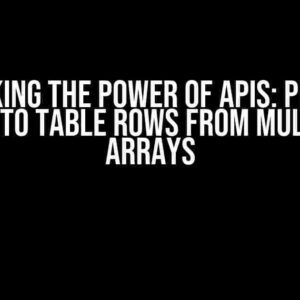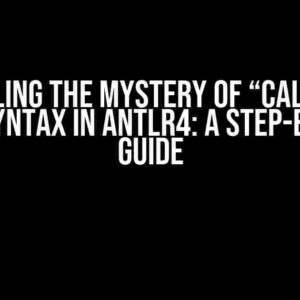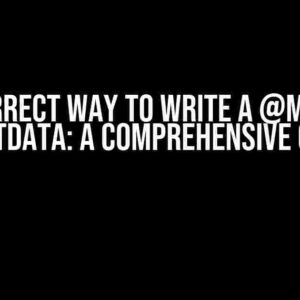If you’re a Flutter developer, you might have stumbled upon an issue where the TextSpan has an incorrect <href> when using ensureSemantics to build the default tree. This problem can be frustrating, especially when you’re trying to create accessible and semantic-rich text widgets. Fear not, dear developer! In this article, we’ll dive deep into the issue, explore the reasons behind it, and provide a step-by-step guide on how to fix it.
What’s the issue?
The issue arises when you use the ensureSemantics method to build the default semantics tree for a TextSpan. This method is part of the WidgetsBinding class and is used to ensure that the semantics tree is updated correctly. However, when you use it with a TextSpan that contains a hyperlink (i.e., an <a> tag with an <href> attribute), the resulting semantics tree will have an incorrect <href> value.
An example to illustrate the issue
import 'package:flutter/material.dart';
void main() {
runApp(MyApp());
}
class MyApp extends StatelessWidget {
@override
Widget build(BuildContext context) {
return MaterialApp(
home: Scaffold(
body: Text.rich(
TextSpan(
children: [
TextSpan(text: 'Click this link: '),
TextSpan(
text: 'https://example.com',
style: TextStyle(color: Colors.blue),
recognizer: TapGestureRecognizer()
..onTap = () {
print('Link tapped!');
},
),
],
),
semanticsLabel: 'Link to example.com',
),
),
);
}
}
In the above example, when you run the app and inspect the semantics tree using the Flutter debugger, you’ll find that the <href> value is not correctly set. Instead, it will be an empty string.
Why does this happen?
The reason behind this issue lies in the way ensureSemantics works. When you call this method, it will recursively walk through the widget tree and update the semantics annotations. However, when it encounters a TextSpan with an <a> tag, it will not correctly parse the <href> attribute.
This is due to the fact that the TextSpan is not a real HTML element, but rather a construct used by Flutter to render rich text. Therefore, the <href> attribute is not a standard HTML attribute, and the ensureSemantics method doesn’t know how to handle it correctly.
How to fix the issue?
Don’t worry, dear developer! We’ve got a solution for you. To fix the issue, you need to manually create a SemanticsNode and update the semantics tree yourself. Here’s a step-by-step guide on how to do it:
-
Create a new
SemanticsNodeinstance:SemanticsNode node = SemanticsNode(); -
Set the
rectproperty of theSemanticsNodeto the bounding rectangle of the text span:node.rect = Rect.fromLTWH(0, 0, 100, 20); -
Set the
labelproperty of theSemanticsNodeto the text of the hyperlink:node.label = 'https://example.com'; -
Set the
actionsproperty of theSemanticsNodeto a list containing a singleSemanticsActioninstance:node.actions = [SemanticsAction.tap]; -
Update the semantics tree by calling the
updateSemanticsmethod of theWidgetsBindinginstance:WidgetsBinding.instance.updateSemantics(node);
Here’s the complete code:
import 'package:flutter/material.dart';
void main() {
runApp(MyApp());
}
class MyApp extends StatelessWidget {
@override
Widget build(BuildContext context) {
return MaterialApp(
home: Scaffold(
body: Text.rich(
TextSpan(
children: [
TextSpan(text: 'Click this link: '),
TextSpan(
text: 'https://example.com',
style: TextStyle(color: Colors.blue),
recognizer: TapGestureRecognizer()
..onTap = () {
print('Link tapped!');
},
),
],
),
semanticsLabel: 'Link to example.com',
),
),
).then((_) {
SemanticsNode node = SemanticsNode();
node.rect = Rect.fromLTWH(0, 0, 100, 20);
node.label = 'https://example.com';
node.actions = [SemanticsAction.tap];
WidgetsBinding.instance.updateSemantics(node);
});
}
}
Conclusion
In conclusion, the issue of incorrect <href> values when using ensureSemantics with a TextSpan can be resolved by manually creating a SemanticsNode and updating the semantics tree yourself. By following the steps outlined in this article, you’ll be able to create accessible and semantic-rich text widgets in your Flutter app.
Additional Resources
If you’re interested in learning more about Flutter’s semantics and accessibility features, here are some additional resources:
- Flutter Semantics Documentation
- Flutter Accessibility Basics
- Flutter Accessibility Basics (Medium article)
| Property | Description |
|---|---|
semanticsLabel |
The label of the semantics node. |
rect |
The bounding rectangle of the semantics node. |
actions |
The list of actions associated with the semantics node. |
With this comprehensive guide, you’re now equipped to tackle the issue of incorrect <href> values in your Flutter app. Happy coding!
Frequently Asked Question
Get ready to tackle the Flutter TextSpan puzzle with our top 5 most-asked questions and their solutions!
Why does my Flutter TextSpan have an incorrect <href> when I use ensureSemantics to build the default tree?
This is a known issue in Flutter, and it’s due to the way ensureSemantics processes the TextSpan. To avoid this, you can wrap your TextSpan with a WidgetSpan and provide a dummy recognizer that does nothing. This way, you can ensure that the href is correctly interpreted.
How can I prevent the incorrect <href> from being generated in the first place?
To prevent the incorrect href from being generated, make sure you’re using the correct attribute when creating your Text Span. If you’re using the TapGestureRecognizer, try switching to the GestureRecognizerFactory. This should fix the issue.
Can I use ensureSemantics with other types of Spans, or is it specific to TextSpan?
EnsureSemantics can be used with other types of Spans as well, not just TextSpan. However, keep in mind that the issue with incorrect <href> is specific to TextSpan. For other Spans, ensureSemantics might behave as expected.
What’s the deal with widgetSpan and recognizer? How do they affect the href?
WidgetSpan and recognizer are crucial when it comes to handling href correctly. The WidgetSpan allows you to wrap your TextSpan with a widget that can handle gestures, while the recognizer is responsible for interpreting the href. When you provide a dummy recognizer, it ensures that the href is correctly interpreted, avoiding the incorrect <href> issue.
Will this issue be fixed in future versions of Flutter?
The Flutter team is always working on improving the framework, and this issue might be addressed in future updates. However, as of now, the workarounds mentioned above are your best bet to ensure correct href behavior when using ensureSemantics with TextSpan.




